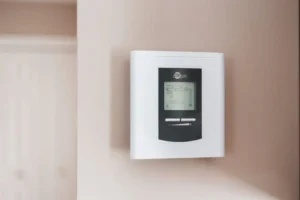Now Reading: Which Air Conditioner Refrigerant Is Best for Your Home
- 01
Which Air Conditioner Refrigerant Is Best for Your Home
- Home
- Home Appliances
- Which Air Conditioner Refrigerant Is Best for Your Home
Which Air Conditioner Refrigerant Is Best for Your Home
![]() Anne MaddisonHome Appliances, Climate ControlAugust 21, 202592 Views
Anne MaddisonHome Appliances, Climate ControlAugust 21, 202592 Views

Shopping for a new air conditioner can feel overwhelming, especially when you start hearing about different refrigerants like R-32, R-410A, and R-454B. If you’re like most homeowners, you probably just want your AC to keep you cool without breaking the bank or harming the planet. But here’s the thing: the type of refrigerant in your air conditioner affects everything from your monthly electric bills to how long your system will last.
The refrigerant world is changing fast. Old refrigerants are being banned because they damage the ozone layer or contribute to global warming. New ones are being introduced that promise better efficiency and less environmental harm. Buying a new AC is already a tough choice, now we also have to decide between the well-established refrigerants and newly introduced ones.
With all these changes happening, you need to know which refrigerant will give you the best value for your money and keep your home comfortable for years to come. Making the wrong choice could mean higher energy bills, expensive repairs, or having to replace your system sooner than expected.
In this guide, we’ll break down everything you need to know about home air conditioner refrigerants in simple terms. You’ll learn about the main types available today, their pros and cons, and most importantly, which one is the best choice for your home in 2025 and beyond.
Understanding Home Air Conditioner Refrigerants
Before we dive into which refrigerant is best, let’s talk about what refrigerants actually do and why they matter so much for your air conditioner’s performance.
Refrigerant is the special liquid that flows through your air conditioner and makes cooling possible. It absorbs heat from inside your home and carries it outside, where it gets released. Think of refrigerant like the blood in your body. Just like blood carries oxygen to keep you alive, refrigerant carries heat to keep your home cool.
Different refrigerants have different properties that affect how well your air conditioner works. Some are better at absorbing heat, while others are safer for the environment. Some require less energy to do their job, while others might be cheaper to buy but more expensive to run.
The refrigerant in your AC also affects safety. Some refrigerants are completely safe, while others can be mildly flammable or toxic if they leak. This is why technicians need special training to work with certain types of refrigerants.
Why Refrigerants Keep Changing
You might wonder why we can’t just stick with one type of refrigerant forever. The problem is that scientists have learned more about how some refrigerants hurt the environment. In 2010, the U.S. stopped the sale of newly manufactured residential air conditioning units and heat pumps that use R-22 because of its particularly harmful impact on the ozone layer when released into the air. On January 1, 2020, the U.S. Environmental Protection Agency (EPA) banned the production of R-22 entirely.
Now the same thing is starting to happen with other refrigerants. The government and environmental groups are pushing for refrigerants that don’t contribute as much to global warming. This means manufacturers are constantly developing new refrigerants that are more environmentally friendly.
How Refrigerants Are Measured
When comparing refrigerants, you’ll see numbers called Global Warming Potential (GWP). This measures how much a refrigerant contributes to global warming compared to carbon dioxide.
Lower numbers are better for the environment. You might also see Ozone Depletion Potential (ODP), which measures damage to the ozone layer. Again, lower numbers are better.
These measurements help you understand why some refrigerants are being phased out and others are being promoted. When shopping for a new AC, looking at these numbers can help you make a choice that’s good for both your wallet and the planet.
If you’re wondering how to choose the right cooling system, our in-depth guide on what air conditioner size you need explains how to pick the best unit for your home and save on energy costs.
Which Home Air Conditioner Refrigerant Is Best
After looking at all the current options, R-32 emerges as the best home air conditioner refrigerant for most homeowners in 2025. Here’s why this refrigerant beats the competition and why experts are recommending it for new installations.
Why R-32 Is the Top Choice
R-32 refrigerant is more environmentally friendly and energy efficient than R-410A, with a significantly lower Global Warming Potential, making it a smart choice for homeowners replacing their AC system. The numbers speak for themselves: R-32 has a GWP of 675, making it 68% less harmful to the environment than R-410A.
But environmental benefits are just part of the story. R-32 systems can reduce energy use by up to 20%, offering long-term savings on electricity bills. This means lower monthly costs for keeping your home cool, which can add up to hundreds of dollars in savings each year.
R-32 has only one-third of the GWP than R-410A, uses 20% less refrigerant, is easier to recycle, and is more efficient. Using less refrigerant means lower costs when your system needs service, and easier recycling means better end-of-life disposal.
How R-32 Compares to Other Options
The main competition for R-32 comes from R-410A (the current standard) and R-454B (another new option). R-32 is a single compound, while R410A is a blend of R-32 and R-125. R-32 is more efficient and requires less refrigerant for cooling.
R-454B is also environmentally friendly, with a GWP of 466, making it even better than R-32 for the environment. However, R-32 has been around longer and is more widely available, making it easier to find technicians who can work with it and parts when you need service.
The One Drawback to Consider
R-32 is moderately flammable, unlike R-410A. This sounds scary, but it’s important to understand that the flammability risk is very low under normal conditions. R-32 requires a very specific mixture with air and an ignition source to catch fire, which is extremely unlikely in a properly installed and maintained system.
Most experts believe the energy and environmental benefits of R-32 far outweigh this small safety consideration, especially since technicians are trained to handle it safely.
Comparing All Home AC Refrigerant Options
To help you make the best decision, let’s look at all the current refrigerant options available for home air conditioners. Each has advantages and disadvantages that might make it better or worse for your specific situation.
R-410A: The Current Standard
R-410A has been the go-to refrigerant for most home air conditioners for the past 15 years. R-410A became the standard for residential and commercial air conditioning systems in many parts of the world due to its superior efficiency and safety profile compared to R-22.
Pros:
- Widely available and well-understood by technicians
- Non-flammable and safe to handle
- Proven track record of reliability
- Lower upfront costs due to widespread adoption
Cons:
- High Global Warming Potential (2,088)
- Less energy efficient than newer alternatives
- Likely to be phased out in the coming years
- R-410A operates at higher pressures, making it harder to handle
R-32: The Energy Efficient Choice
As we discussed, R-32 offers the best combination of efficiency, environmental friendliness, and availability for most homeowners.
Pros:
- 20% more energy efficient than R-410A
- 68% lower Global Warming Potential than R-410A
- Uses less refrigerant, reducing costs
- Easier to recycle at end of life
- Increasingly available from major manufacturers
Cons:
- Mildly flammable (requires special handling)
- Slightly higher upfront equipment costs
- Fewer technicians trained to work with it (though this is changing)
R-454B: The Environmental Champion
R-454B is the newest refrigerant option and offers the best environmental performance currently available.
Pros:
- Lowest Global Warming Potential (466)
- Similar efficiency to R-32
- Non-flammable and safe to handle
- Future-proof choice unlikely to be phased out
Cons:
- Most expensive option upfront
- Limited availability of equipment and technicians
- Newest technology with less long-term data
- May have compatibility issues with some older systems
R-22: The Phased-Out Option
If you have an older air conditioner, it probably uses R-22 refrigerant. While this refrigerant worked well for decades, it’s no longer an option for new systems.
New production and import of most hydrochlorofluorocarbons (HCFCs) were phased out as of 2020. R-22 phaseout in 2020 means that it’s completely illegal to manufacture or import R-22 in the U.S. You can still get recycled R-22 to repair older systems, but the price of recycled refrigerant will continue to increase as the supply decreases.
Expert Tips for Choosing the Right Refrigerant for Your Home
Now that you understand the options, here are some practical tips to help you choose the best refrigerant for your specific situation and needs.
Consider Your Long-Term Plans
If you’re planning to stay in your home for many years, investing in R-32 or R-454B makes sense because of the energy savings and environmental benefits. The higher upfront cost will pay for itself through lower electricity bills over time.
If you’re planning to move within a few years, R-410A might still be a reasonable choice since it costs less upfront and is widely supported by technicians.
Think About Your Local Climate
In very hot climates where your AC runs constantly, the energy efficiency of R-32 becomes even more important. The 20% energy savings can translate to significant monthly savings when your system is working hard all summer long.
In milder climates where your AC doesn’t run as much, the energy difference between refrigerants won’t be as noticeable in your bills.
Check Local Technician Availability
Before choosing a refrigerant, make sure you can find qualified technicians in your area who can service it. Call a few local HVAC companies and ask about their experience with different refrigerants.
R-410A has the widest technician support, followed by R-32, then R-454B. However, most good HVAC companies are training their technicians on the newer refrigerants as they become more common.
Factor in Future Regulations
Environmental regulations are getting stricter, and refrigerants with high Global Warming Potential may face restrictions or higher taxes in the future. Choosing a low-GWP refrigerant like R-32 or R-454B protects you from potential future costs or regulations.
Consider Your Budget
While R-32 and R-454B systems cost more upfront, they often pay for themselves through energy savings. Calculate the potential energy savings based on your current cooling costs to see if the higher upfront cost makes sense for your situation.
Don’t forget to factor in potential rebates or tax credits for high-efficiency systems. Many utility companies and government programs offer incentives for choosing environmentally friendly refrigerants.
Common Mistakes When Choosing AC Refrigerants
Avoiding these common mistakes will help you make the best refrigerant choice for your home and avoid problems down the road.
Focusing Only on Upfront Cost
The biggest mistake homeowners make is choosing the cheapest option without considering long-term costs. A less expensive R-410A system might cost $500-$1000 less than an R-32 system, but the R-32 system could save $200-400 per year in energy costs. Over the system’s 15-20 year lifespan, the R-32 system will cost much less overall.
Ignoring Future Availability
Some homeowners choose older refrigerants like R-410A without thinking about what happens when they need repairs in 10-15 years. R-410A will most likely get replaced with the following leading Freons: R-32 and R-454B, which will start the phase-out process. Choosing a refrigerant that might be phased out could lead to expensive repairs or early system replacement.
Not Considering Environmental Impact
While environmental impact might not affect your wallet immediately, choosing refrigerants with high Global Warming Potential contributes to climate change and may face future taxes or restrictions. Making an environmentally responsible choice now protects you from potential future costs.
Assuming All Systems Are the Same
Different manufacturers may offer different refrigerants in their systems, and not all systems using the same refrigerant perform equally. Make sure to compare the overall efficiency and quality of the system, not just the refrigerant type.
Not Checking Warranty Coverage
Some manufacturers offer better warranty coverage for systems using newer refrigerants like R-32 or R-454B. This could provide additional protection for your investment and lower long-term costs.
Skipping Professional Consultation
While online research is helpful, every home is different. A qualified HVAC professional can assess your specific needs, local climate, and usage patterns to recommend the best refrigerant choice for your situation.
Not sure which cooling solution fits your home best? Explore our detailed comparison of what type of air conditioner is best for your home to help you choose the right unit for your space and needs.
Conclusion
When it comes to which home air conditioner refrigerant is best, R-32 stands out as the clear winner for most homeowners in 2025. It offers the best balance of energy efficiency, environmental friendliness, and availability. With 20% better energy efficiency than R-410A and 68% lower Global Warming Potential, R-32 delivers both lower monthly bills and a smaller environmental footprint.
While R-454B offers even better environmental performance, R-32’s wider availability and proven track record make it the safer choice for most homeowners. The mild flammability of R-32 is a minimal concern when systems are properly installed and maintained by qualified technicians.
For homeowners with existing R-22 systems, upgrading to R-32 is definitely worth considering. The old R-22 refrigerant is no longer manufactured, making repairs increasingly expensive. A new R-32 system will provide much better efficiency and reliability.
The key is to think long-term when choosing a refrigerant. While R-410A systems might cost less upfront, the energy savings and future-proofing of R-32 make it the better investment for most homes. As environmental regulations continue to tighten, choosing a low-GWP refrigerant now protects you from potential future restrictions or costs.
Ready to choose the best refrigerant for your home? Start by getting quotes from local HVAC contractors for R-32 systems and compare them to R-410A options. Factor in energy savings, warranty coverage, and long-term availability when making your decision. Don’t forget to ask about rebates or incentives for high-efficiency systems in your area.
Related Posts
Previous Post
Next Post
Previous Post
Next Post
Climate ControlJuly 28, 2025
Can Air Conditioner Make You Sick?
Home AppliancesJuly 27, 2025
What Air Conditioner Size Do I Need?
Home AppliancesAugust 24, 2025
Are Home Air Conditioner Tune Ups Necessary
Climate ControlAugust 23, 2025
Can Air Conditioning at Home Trigger Asthma?
- 03
Home AppliancesJuly 28, 2025
Can Air Conditioner Make You Sick?
- 04
Climate ControlJuly 27, 2025
What Air Conditioner Size Do I Need?






















